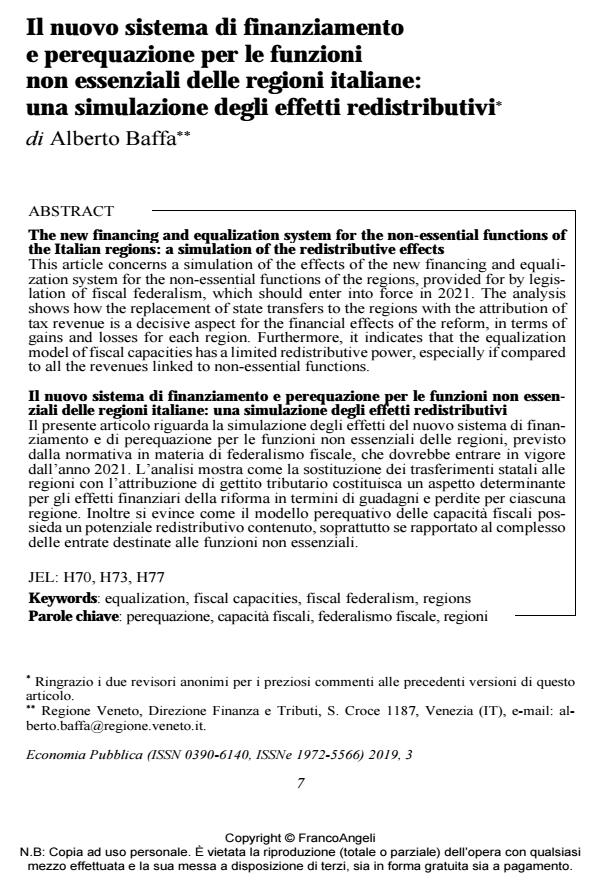The new financing and equalization system for the non-essential functions of the Italian regions: a simulation of the redistributive effects
Journal title ECONOMIA PUBBLICA
Author/s Alberto Baffa
Publishing Year 2020 Issue 2019/3
Language Italian Pages 34 P. 7-40 File size 249 KB
DOI 10.3280/EP2019-003001
DOI is like a bar code for intellectual property: to have more infomation
click here
Below, you can see the article first page
If you want to buy this article in PDF format, you can do it, following the instructions to buy download credits

FrancoAngeli is member of Publishers International Linking Association, Inc (PILA), a not-for-profit association which run the CrossRef service enabling links to and from online scholarly content.
This article concerns a simulation of the effects of the new financing and equalization system for the non-essential functions of the regions, provided for by legislation of fiscal federalism, which should enter into force in 2021. The analysis shows how the replacement of state transfers to the regions with the attribution of tax revenue is a decisive aspect for the financial effects of the reform, in terms of gains and losses for each region. Furthermore, it indicates that the equalization model of fiscal capacities has a limited redistributive power, especially if compared to all the revenues linked to non-essential functions.
Keywords: Equalization, fiscal capacities, fiscal federalism, regions
Jel codes: H70, H73, H77
- Dafflon B. and Vaillancourt F. (2003). Problems of equalisation in federal systems. Federalism in a changing world: learning from each other, 395-411. Kingston: Queen’s University Press.
- Fiorillo F. (2002). Perequazione e incentivi all’accertamento regionale della base imponibile delle imposte proprie. Società Italiana di Economia Pubblica working papers, 117.
- Gini C. (1912). Variabilità e mutabilità, contributo allo studio delle distribuzioni e relazioni statistiche. Bologna: Tipografia Paolo Cuppini.
- Governo Repubblica Italiana (2010). Relazione del Governo alle Camere in ottemperanza alla disposizione dell’art. 2, comma 6, della legge 5 maggio 2009, n. 42. -- Disponibile su http://www.mef.gov.it al 30 gennaio 2017.
- Grazzini L. and Petretto A. (2012). Revenue equalization systems in a federation with tax evasion. Finanz Archiv, (68)3: 303-330.
- IFEL (2016). Capacità fiscali e fabbisogni standard: la nuova perequazione comunale per il 2017, -- disponibile su http://www.fondazioneifel.it al 30 novembre 2017.
- Kaufman M., Swagel P. and Dunaway S. (2003). Regional convergence and the role of federal transfers in Canada. IMF Working papers, n. 03/97. DOI: 10.5089/9781451852042.001
- Martinez-Vazquez J. and Boex J. (2001). The design of equalization grants: theory
- and applications. Part one: theory and concepts. Washington: Word Bank.
- Messina G. (2001). Decentramento fiscale e perequazione regionale. Efficienza e redistribuzione nel nuovo sistema di finanziamento delle regioni a statuto ordinario. Temi di Discussione del Servizio Studi della Banca d’Italia, n. 416.
- Ministero dell’Economia e delle Finanze. Banca dati delle Amministrazioni pubbliche -- disponibile su http://bdapservice.mef.gov.it/ al 15 gennaio 2018.
- Musgrave R.A. (1971). Economics of fiscal federalism. Nebraska Journal of Economics and Business, 10(4): 3-13.
- Pigou A.C. (1929). A study in public finance. London: Macmillan.
- Schroeder L. and Smoke P. (2003). Intergovernmental fiscal transfers: concepts, international practice, and policy issues. In: Smoke P. and Kim Y.H. (Eds.). Intergovernmental transfers in Asia: current practice and challenges for the future, 20-59. Manila: Asian Development Bank.
- Shah A. (1996). A fiscal need approach to equalization. Canadian public policy, analyse de politiques, 22(2): 99-115.
- Smart M. (2002). Redistribution, risk, and incentives in equalization: a comparison of RTS and macro approaches. Kingston: Queen’s University, Institute for Intergovernmental.
- Staderini A. e Vadalà E. (2009). Bilancio pubblico e flussi redistributivi interregionali: ricostruzione e analisi dei residui fiscali nelle regioni italiane. In: Cannari L. (a cura di). Mezzogiorno e politiche regionali. Roma: Banca d’Italia.
- Tiebout C.M. (1956). A pure theory of local expenditures. The Journal of Political Economy, 64(5): 416-424. Vaillancourt F. and Bird R.M. (2004). Expenditure-based equalization transfers. International studies program working papers, 4-10.
- Wilson L.S. (2007). Macro formulas for equalization. In: Boadway R. and Shah A. (Eds.). Intergovernmental fiscal transfers. Principles and practice. Washington: World Bank. DOI: 10.1596/978-0-8213-6492-5
- Agenzia per la Coesione Territoriale. Catalogo Open CPT, -- disponibile su www.agenziacoesione.gov.it al 15 gennaio 2018.
- Alesina A., Danninger S. and Rostagno M.V. (1999). Redistribution through public employment: the case of Italy. IMF working papers, 7387.
- Ambrosanio M.F. e Balduzzi P. (2011). Federalismo fiscale: a che punto siamo? Osservatorio Monetario, 2: 66-84.
- Bird R. and Slack E. (1990). Equalization: the representative tax system revisited. Canadian Tax Journal, 38: 913-927.
- Blochliger H. and Charbit C. (2008). Fiscal equalization. OECD Economic Studies, 1(44).
- Boadway R. (2004). The theory and practice of equalization. CESifo Economic Studies, 50(1): 211-254.
- Boadway R. (2007). Grants in a federal economy: a conceptual perspective. In: Boadway R. and Shah A. (Eds.). Intergovernmental fiscal transfers. Principles and pratice. Washington: World Bank. DOI: 10.1596/978-0-8213-6492-5
- Bordignon M., Manasse P. and Tabellini G. (1996). Optimal regional redistribution under asymmetric information. IGIER working papers, 93.
- Bordignon M., Manasse P. e Tabellini G. (1997). Come fare la perequazione regionale in Italia? IGIER working papers, 107.
- Buchanan J.M. and Goetz C.J. (1972). Efficiency limits of fiscal mobility – an assessment of Tiebout model. Journal of Public Economics, 1: 25-43. DOI: 10.1016/0047-2727(72)90018-7
- Corte dei Conti (2016). Audizione della Corte dei conti sui Trasferimenti finanziari agli enti territoriali. Dafflon B. (2007). Fiscal capacity equalization in horizontal fiscal equalization programs. In: Boadway R. and Shah A. (Eds.). Intergovernmental fiscal transfers. Principles and practice. Washington: World Bank. DOI: 10.1596/978-0-8213-6492-5
- Path-dependency and corporate governance in Italy: The political origins of debt financing Antonio Nicita, Riccardo Vannini, in Corporate Ownership and Control /2007 pp.92
DOI: 10.22495/cocv4i4c4p8
Alberto Baffa, Il nuovo sistema di finanziamento e perequazione per le funzioni non essenziali delle regioni italiane: una simulazione degli effetti redistributivi in "ECONOMIA PUBBLICA " 3/2019, pp 7-40, DOI: 10.3280/EP2019-003001